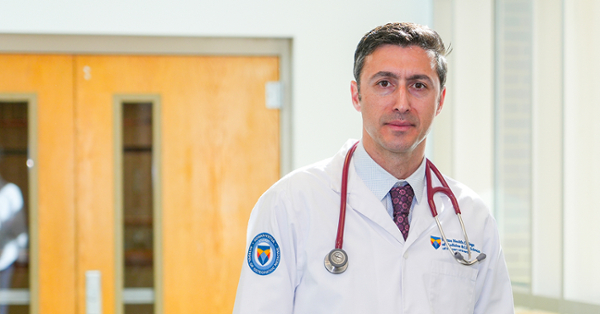Bijan Roghanchi's non-traditional journey from art to medicine
Bijan Roghanchi's non-traditional journey from art to medicine

For years, Bijan Roghanchi’s favorite tools were a camera, a pen and a paintbrush. As a photographer traveling the world, he captured the lives and communities of people in Spain, Morocco, Iran and beyond. He believed he could make a difference by giving a voice to their struggles and sharing their stories. But over time, he realized that what many of these communities needed weren’t photographers; they needed doctors.
“At some point, you think, ‘What am I going to do—take a picture of these kids when they have no doctors, no health care here?’” he said. “That became the drive to get into medicine.”
Roghanchi holds a Bachelor of Arts in photography from New Jersey City University and has earned certificates from universities in Spain, France and Iran. His work has been published nationally and internationally, including his 2016 book “Becoming Iranian,” which explores themes of nationalism and identity in contemporary Iran while also chronicling his personal journey as an Iranian-American.
In 2017, he shifted his career path and enrolled as a Doctor of Osteopathic Medicine candidate at the Rowan-Virtua School of Osteopathic Medicine. His decision wasn’t just about medicine but about recognizing the many similarities between art and health care. Both require understanding people, noticing the details others might miss, and, ultimately, making an impact.
“I think as an artist, that’s what I was looking for when I came to medicine,” he said. “It’s just another brush. When I’m sitting in front of a patient, my process is no different than if I was holding a camera instead of a stethoscope.”
Finding his place at Rowan
At Rowan, Roghanchi immediately felt at home. He appreciated how the school emphasized not just the science of medicine but also the art of healing. He also valued the balance between independence and structure in the curriculum.
“I knew pretty quickly that this was the place for me,” he said. “It’s an environment that allowed me the independence to find my voice as a future clinician. I needed enough structure so I wouldn’t get lost and enough freedom to push my limits. At Rowan, I was able to experience that.”
Returning to academia after years away, however, was not always easy. Roghanchi had to adjust to new technologies, like using an iPad for coursework—a tool he didn’t own when he first arrived. Even standardized testing felt different. Until he took the Medical College Admission Test (MCAT), he had never taken an exam on a computer before.
However, it was his connection with faculty members that helped him bridge the gap. As a 39-year-old medical student, he took comfort in their guidance and encouragement.
“The faculty was so forward-thinking,” Roghanchi said. “They could see where I was and where I needed to go, and they gave me just enough support to keep me heading in the right direction. That happened over and over again throughout the last four years.”
Blending art and medicine to serve the community
Outside the classroom, Roghanchi found ways to merge his passion for storytelling with his growing commitment to medicine.
He mentored young men at a Camden, New Jersey, group home, where he helped organize monthly health-related sessions and meals while assisting them in setting and achieving personal goals. In 2024, he led a student group for a grant-funded project with The Arnold P. Gold Foundation and Migrant Health Collaborative of South Jersey.
Working alongside undergraduate, graduate, medical students and resident physicians, Roghanchi organized a health screening event that provided screenings for various health conditions and offered vision and dental services to migrant farm workers. He also documented the project in a mini documentary, hoping to share it with physicians and potential funders. His goal was to help them see the program’s impact firsthand and encourage more support for similar initiatives.
“The people writing checks for these programs don’t always want to read a paper about it. But a two-minute video on Instagram or YouTube that goes viral can be way more impactful,” he explained. “The goal was always to create a narrative that brought people together—not as ‘us versus them’ but as a shared community, making the issues more immediate and impossible to ignore. I think we were successful in doing that.”
A vision for “Total Medicine”
In March, Roghanchi matched into Jefferson Northeast’s Emergency Medicine/Family Medicine combined residency program—his top choice. The milestone validated the hard work and challenges he overcame to transition into medicine.
Beyond graduation, his immediate plans are practical: finding housing in Philadelphia and settling into residency life. But he has big ideas about the impact he hopes to make in medicine and the legacy he wants to leave behind.
“I have a vision for something I call ‘total medicine,’ which is creating community centers built around primary care clinics,” he said. “The concept is to bring all our skills to the communities that need them instead of making them come to us.
“If, at the end of my career—whenever that may be—I’m remembered by some people as a good doctor, that would be a massive win.”